Finance Report: Hatfield Manufacturing Systems Plc Investment Proposal
VerifiedAdded on 2022/09/10
|11
|2596
|28
Report
AI Summary
This report critically evaluates an investment proposal by Hatfield Manufacturing Systems Plc, an engineering firm specializing in 3D print machines, to establish a new plant in Turkey for manufacturing components for the motor vehicle and aerospace industries. The report employs capital budgeting techniques, including net present value, payback period, and internal rate of return, to assess the project's financial viability, considering sales growth, labor costs, tax rates, and the company's beta. The analysis reveals positive net present value, a payback period of 6.153 years, and an internal rate of return exceeding the cost of capital, supporting the investment. Furthermore, the report identifies and analyzes the foreign exchange risk associated with the international project, acknowledging the potential impact of currency fluctuations on earnings and cash flow. Strategies to mitigate these risks, such as hedging with specialized exchange-traded funds, forward contracts, and currency options, are also discussed. The report concludes that the project is financially sound and provides recommendations for managing foreign exchange risks.

Running head: FINANCE FOR INTERNATIONAL BUSINESS
Finance for international business
Name of the Student
Name of the University
Author Note
Finance for international business
Name of the Student
Name of the University
Author Note
Paraphrase This Document
Need a fresh take? Get an instant paraphrase of this document with our AI Paraphraser
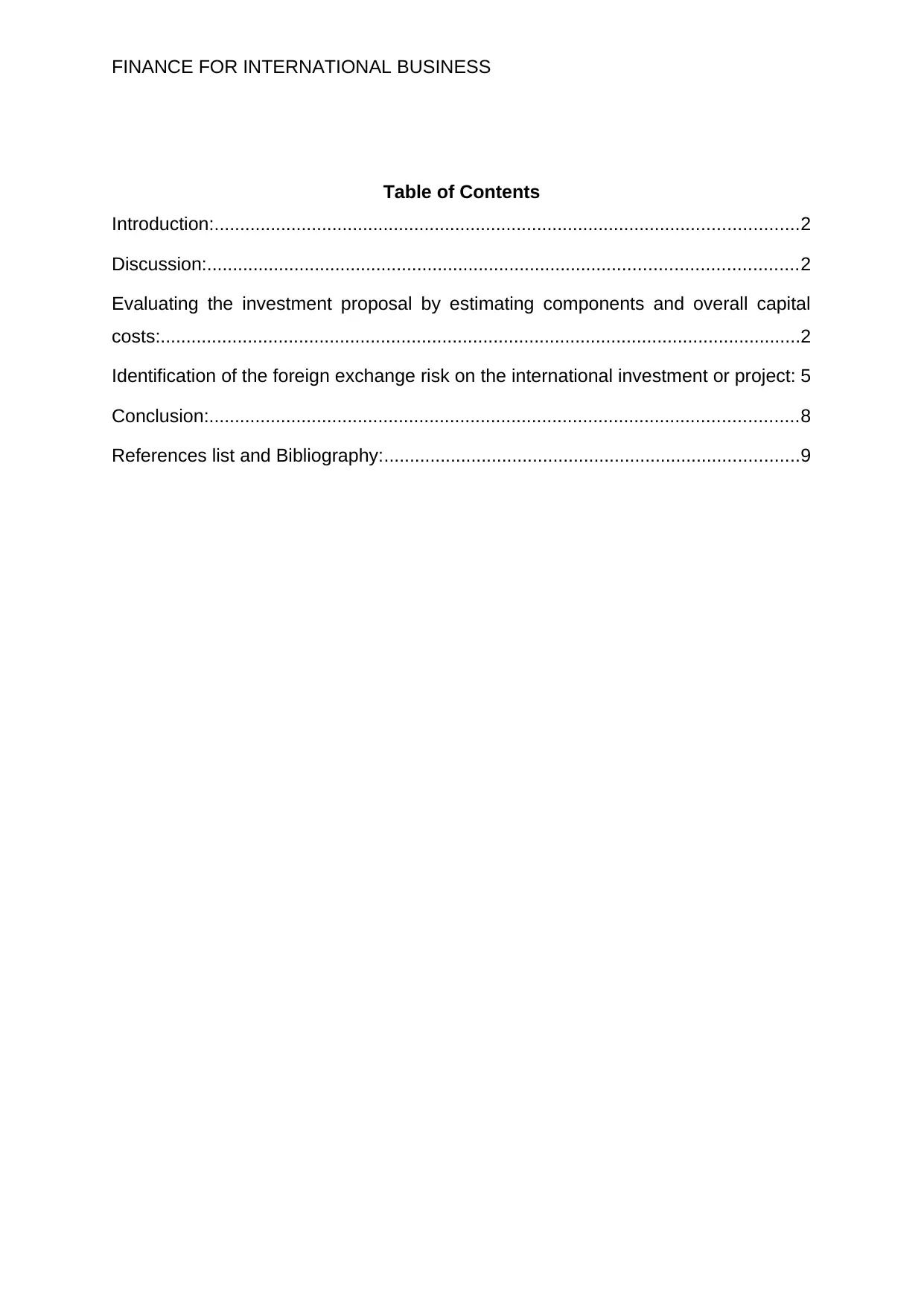
FINANCE FOR INTERNATIONAL BUSINESS
Table of Contents
Introduction:..................................................................................................................2
Discussion:...................................................................................................................2
Evaluating the investment proposal by estimating components and overall capital
costs:.............................................................................................................................2
Identification of the foreign exchange risk on the international investment or project: 5
Conclusion:...................................................................................................................8
References list and Bibliography:.................................................................................9
Table of Contents
Introduction:..................................................................................................................2
Discussion:...................................................................................................................2
Evaluating the investment proposal by estimating components and overall capital
costs:.............................................................................................................................2
Identification of the foreign exchange risk on the international investment or project: 5
Conclusion:...................................................................................................................8
References list and Bibliography:.................................................................................9
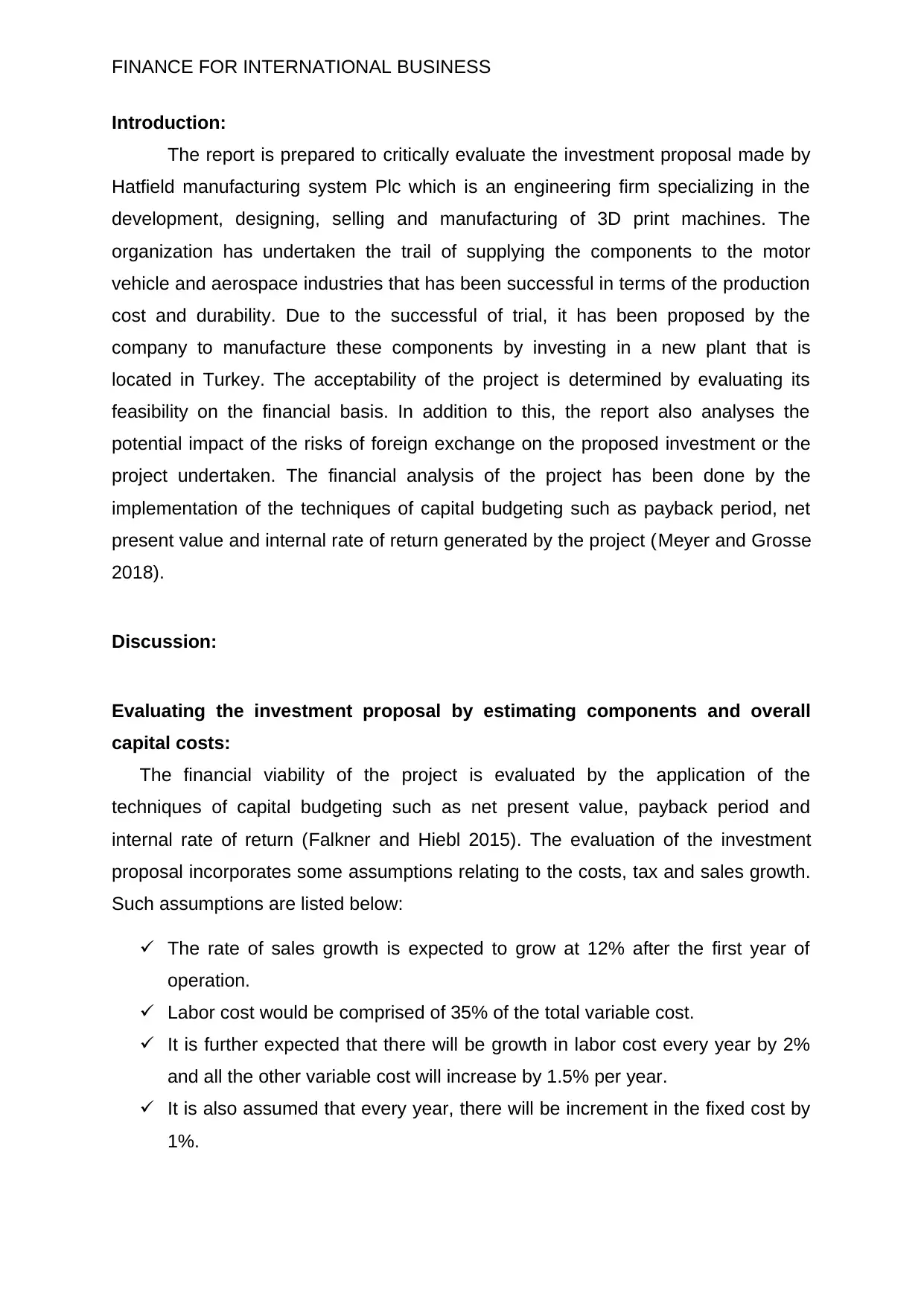
FINANCE FOR INTERNATIONAL BUSINESS
Introduction:
The report is prepared to critically evaluate the investment proposal made by
Hatfield manufacturing system Plc which is an engineering firm specializing in the
development, designing, selling and manufacturing of 3D print machines. The
organization has undertaken the trail of supplying the components to the motor
vehicle and aerospace industries that has been successful in terms of the production
cost and durability. Due to the successful of trial, it has been proposed by the
company to manufacture these components by investing in a new plant that is
located in Turkey. The acceptability of the project is determined by evaluating its
feasibility on the financial basis. In addition to this, the report also analyses the
potential impact of the risks of foreign exchange on the proposed investment or the
project undertaken. The financial analysis of the project has been done by the
implementation of the techniques of capital budgeting such as payback period, net
present value and internal rate of return generated by the project (Meyer and Grosse
2018).
Discussion:
Evaluating the investment proposal by estimating components and overall
capital costs:
The financial viability of the project is evaluated by the application of the
techniques of capital budgeting such as net present value, payback period and
internal rate of return (Falkner and Hiebl 2015). The evaluation of the investment
proposal incorporates some assumptions relating to the costs, tax and sales growth.
Such assumptions are listed below:
The rate of sales growth is expected to grow at 12% after the first year of
operation.
Labor cost would be comprised of 35% of the total variable cost.
It is further expected that there will be growth in labor cost every year by 2%
and all the other variable cost will increase by 1.5% per year.
It is also assumed that every year, there will be increment in the fixed cost by
1%.
Introduction:
The report is prepared to critically evaluate the investment proposal made by
Hatfield manufacturing system Plc which is an engineering firm specializing in the
development, designing, selling and manufacturing of 3D print machines. The
organization has undertaken the trail of supplying the components to the motor
vehicle and aerospace industries that has been successful in terms of the production
cost and durability. Due to the successful of trial, it has been proposed by the
company to manufacture these components by investing in a new plant that is
located in Turkey. The acceptability of the project is determined by evaluating its
feasibility on the financial basis. In addition to this, the report also analyses the
potential impact of the risks of foreign exchange on the proposed investment or the
project undertaken. The financial analysis of the project has been done by the
implementation of the techniques of capital budgeting such as payback period, net
present value and internal rate of return generated by the project (Meyer and Grosse
2018).
Discussion:
Evaluating the investment proposal by estimating components and overall
capital costs:
The financial viability of the project is evaluated by the application of the
techniques of capital budgeting such as net present value, payback period and
internal rate of return (Falkner and Hiebl 2015). The evaluation of the investment
proposal incorporates some assumptions relating to the costs, tax and sales growth.
Such assumptions are listed below:
The rate of sales growth is expected to grow at 12% after the first year of
operation.
Labor cost would be comprised of 35% of the total variable cost.
It is further expected that there will be growth in labor cost every year by 2%
and all the other variable cost will increase by 1.5% per year.
It is also assumed that every year, there will be increment in the fixed cost by
1%.
⊘ This is a preview!⊘
Do you want full access?
Subscribe today to unlock all pages.

Trusted by 1+ million students worldwide
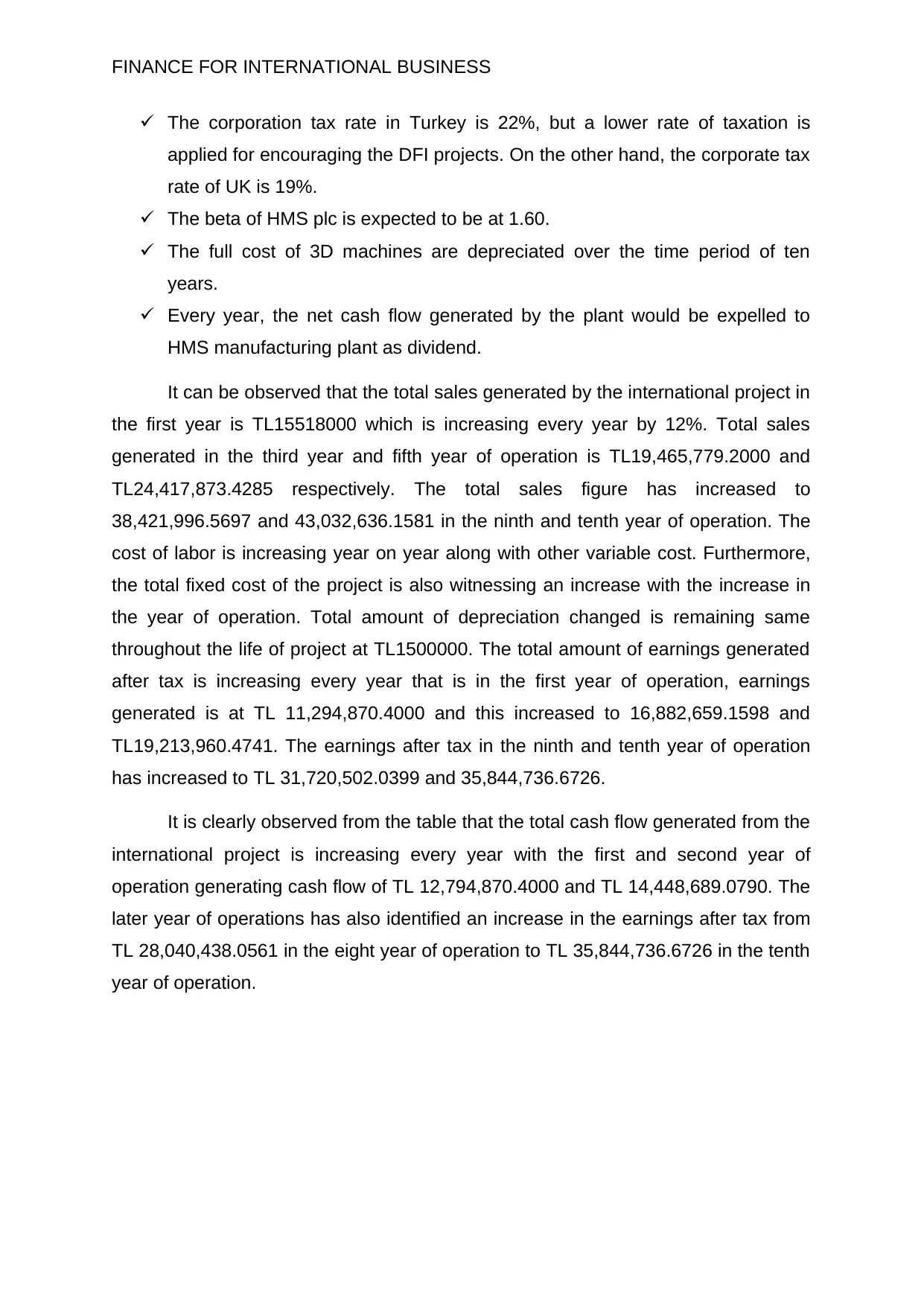
FINANCE FOR INTERNATIONAL BUSINESS
The corporation tax rate in Turkey is 22%, but a lower rate of taxation is
applied for encouraging the DFI projects. On the other hand, the corporate tax
rate of UK is 19%.
The beta of HMS plc is expected to be at 1.60.
The full cost of 3D machines are depreciated over the time period of ten
years.
Every year, the net cash flow generated by the plant would be expelled to
HMS manufacturing plant as dividend.
It can be observed that the total sales generated by the international project in
the first year is TL15518000 which is increasing every year by 12%. Total sales
generated in the third year and fifth year of operation is TL19,465,779.2000 and
TL24,417,873.4285 respectively. The total sales figure has increased to
38,421,996.5697 and 43,032,636.1581 in the ninth and tenth year of operation. The
cost of labor is increasing year on year along with other variable cost. Furthermore,
the total fixed cost of the project is also witnessing an increase with the increase in
the year of operation. Total amount of depreciation changed is remaining same
throughout the life of project at TL1500000. The total amount of earnings generated
after tax is increasing every year that is in the first year of operation, earnings
generated is at TL 11,294,870.4000 and this increased to 16,882,659.1598 and
TL19,213,960.4741. The earnings after tax in the ninth and tenth year of operation
has increased to TL 31,720,502.0399 and 35,844,736.6726.
It is clearly observed from the table that the total cash flow generated from the
international project is increasing every year with the first and second year of
operation generating cash flow of TL 12,794,870.4000 and TL 14,448,689.0790. The
later year of operations has also identified an increase in the earnings after tax from
TL 28,040,438.0561 in the eight year of operation to TL 35,844,736.6726 in the tenth
year of operation.
The corporation tax rate in Turkey is 22%, but a lower rate of taxation is
applied for encouraging the DFI projects. On the other hand, the corporate tax
rate of UK is 19%.
The beta of HMS plc is expected to be at 1.60.
The full cost of 3D machines are depreciated over the time period of ten
years.
Every year, the net cash flow generated by the plant would be expelled to
HMS manufacturing plant as dividend.
It can be observed that the total sales generated by the international project in
the first year is TL15518000 which is increasing every year by 12%. Total sales
generated in the third year and fifth year of operation is TL19,465,779.2000 and
TL24,417,873.4285 respectively. The total sales figure has increased to
38,421,996.5697 and 43,032,636.1581 in the ninth and tenth year of operation. The
cost of labor is increasing year on year along with other variable cost. Furthermore,
the total fixed cost of the project is also witnessing an increase with the increase in
the year of operation. Total amount of depreciation changed is remaining same
throughout the life of project at TL1500000. The total amount of earnings generated
after tax is increasing every year that is in the first year of operation, earnings
generated is at TL 11,294,870.4000 and this increased to 16,882,659.1598 and
TL19,213,960.4741. The earnings after tax in the ninth and tenth year of operation
has increased to TL 31,720,502.0399 and 35,844,736.6726.
It is clearly observed from the table that the total cash flow generated from the
international project is increasing every year with the first and second year of
operation generating cash flow of TL 12,794,870.4000 and TL 14,448,689.0790. The
later year of operations has also identified an increase in the earnings after tax from
TL 28,040,438.0561 in the eight year of operation to TL 35,844,736.6726 in the tenth
year of operation.
Paraphrase This Document
Need a fresh take? Get an instant paraphrase of this document with our AI Paraphraser

FINANCE FOR INTERNATIONAL BUSINESS
Table 1:
(Total cashflow of Hatfeild)
From the analysis of the overall cash flow, the calculated value of net present
value is recorded at TL 17,526,791.1233. In accordance with the rule of net present
value, it is feasible to accept the project with positive net present value. Hence, as
per the acceptance criteria of net present value, the investment proposal should be
accepted.
The payback period of the investment proposal is 6.153 years which implies
that the initial investment made by Hatfield manufacturing system plc would be
recovered in the time period of six years and one and a half months. That is the
initial amount invested in the business would be recovered within the life time of the
project. On other hand, the figure generated by the internal rate of return helps in
analyzing whether the return generated by the investment or the money made by the
project is more than the actual costs that is incurred (Bussière et al. 2018). The
desirability of the investment project can be evaluated by the computation of the
figure of internal rate of return. It is suggested to undertake the investment with
higher internal rate of return. The internal rate of return of the investment proposal is
13.372% and the weighted average cost of capital of the project is 10.39%. It is
clearly observed from the computred figures that the internal rate of return generated
by the project is higher than the cost of capital. Therefore, it is advisable that the
international investment project should be accepted.
Table 1:
(Total cashflow of Hatfeild)
From the analysis of the overall cash flow, the calculated value of net present
value is recorded at TL 17,526,791.1233. In accordance with the rule of net present
value, it is feasible to accept the project with positive net present value. Hence, as
per the acceptance criteria of net present value, the investment proposal should be
accepted.
The payback period of the investment proposal is 6.153 years which implies
that the initial investment made by Hatfield manufacturing system plc would be
recovered in the time period of six years and one and a half months. That is the
initial amount invested in the business would be recovered within the life time of the
project. On other hand, the figure generated by the internal rate of return helps in
analyzing whether the return generated by the investment or the money made by the
project is more than the actual costs that is incurred (Bussière et al. 2018). The
desirability of the investment project can be evaluated by the computation of the
figure of internal rate of return. It is suggested to undertake the investment with
higher internal rate of return. The internal rate of return of the investment proposal is
13.372% and the weighted average cost of capital of the project is 10.39%. It is
clearly observed from the computred figures that the internal rate of return generated
by the project is higher than the cost of capital. Therefore, it is advisable that the
international investment project should be accepted.
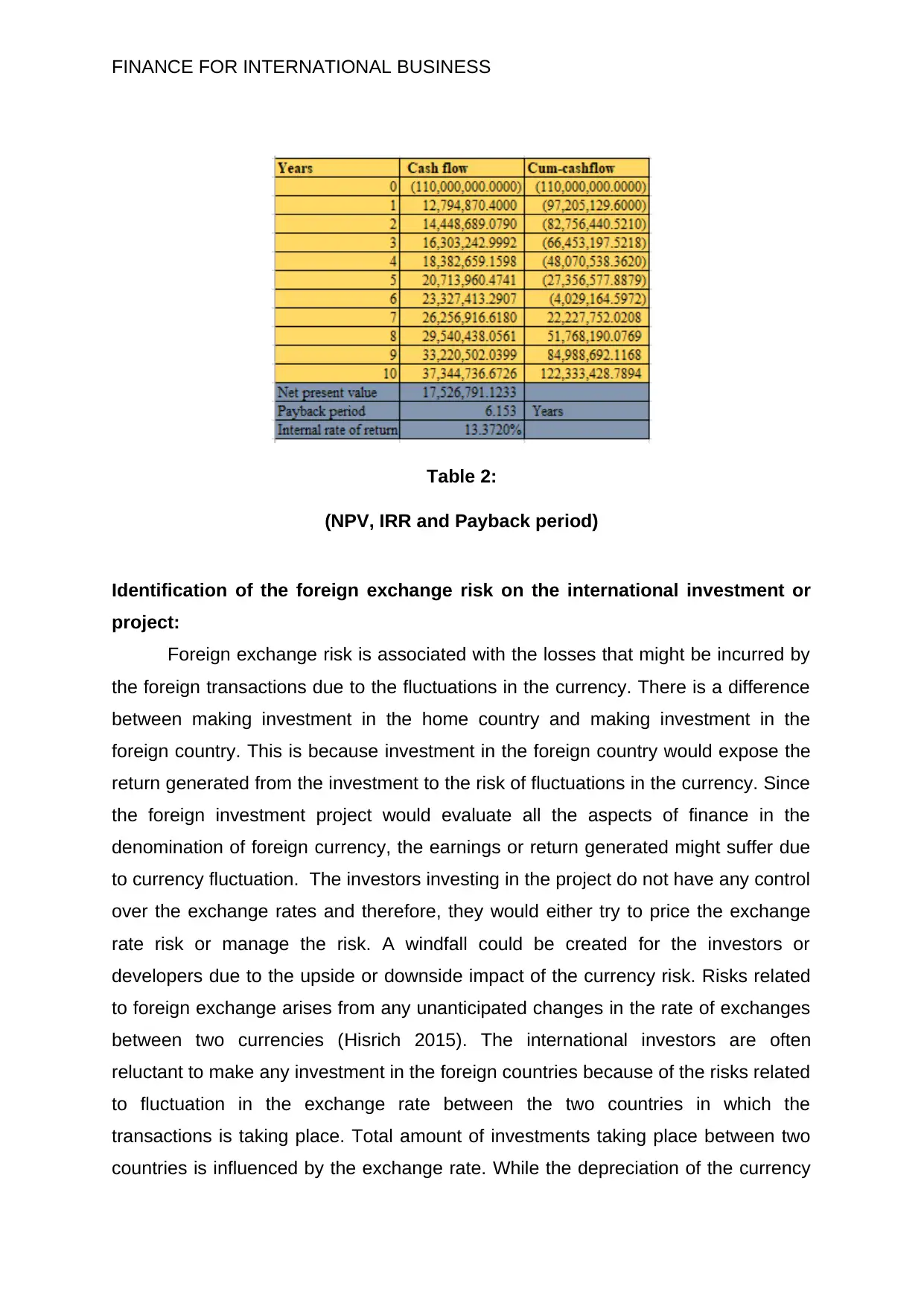
FINANCE FOR INTERNATIONAL BUSINESS
Table 2:
(NPV, IRR and Payback period)
Identification of the foreign exchange risk on the international investment or
project:
Foreign exchange risk is associated with the losses that might be incurred by
the foreign transactions due to the fluctuations in the currency. There is a difference
between making investment in the home country and making investment in the
foreign country. This is because investment in the foreign country would expose the
return generated from the investment to the risk of fluctuations in the currency. Since
the foreign investment project would evaluate all the aspects of finance in the
denomination of foreign currency, the earnings or return generated might suffer due
to currency fluctuation. The investors investing in the project do not have any control
over the exchange rates and therefore, they would either try to price the exchange
rate risk or manage the risk. A windfall could be created for the investors or
developers due to the upside or downside impact of the currency risk. Risks related
to foreign exchange arises from any unanticipated changes in the rate of exchanges
between two currencies (Hisrich 2015). The international investors are often
reluctant to make any investment in the foreign countries because of the risks related
to fluctuation in the exchange rate between the two countries in which the
transactions is taking place. Total amount of investments taking place between two
countries is influenced by the exchange rate. While the depreciation of the currency
Table 2:
(NPV, IRR and Payback period)
Identification of the foreign exchange risk on the international investment or
project:
Foreign exchange risk is associated with the losses that might be incurred by
the foreign transactions due to the fluctuations in the currency. There is a difference
between making investment in the home country and making investment in the
foreign country. This is because investment in the foreign country would expose the
return generated from the investment to the risk of fluctuations in the currency. Since
the foreign investment project would evaluate all the aspects of finance in the
denomination of foreign currency, the earnings or return generated might suffer due
to currency fluctuation. The investors investing in the project do not have any control
over the exchange rates and therefore, they would either try to price the exchange
rate risk or manage the risk. A windfall could be created for the investors or
developers due to the upside or downside impact of the currency risk. Risks related
to foreign exchange arises from any unanticipated changes in the rate of exchanges
between two currencies (Hisrich 2015). The international investors are often
reluctant to make any investment in the foreign countries because of the risks related
to fluctuation in the exchange rate between the two countries in which the
transactions is taking place. Total amount of investments taking place between two
countries is influenced by the exchange rate. While the depreciation of the currency
⊘ This is a preview!⊘
Do you want full access?
Subscribe today to unlock all pages.

Trusted by 1+ million students worldwide
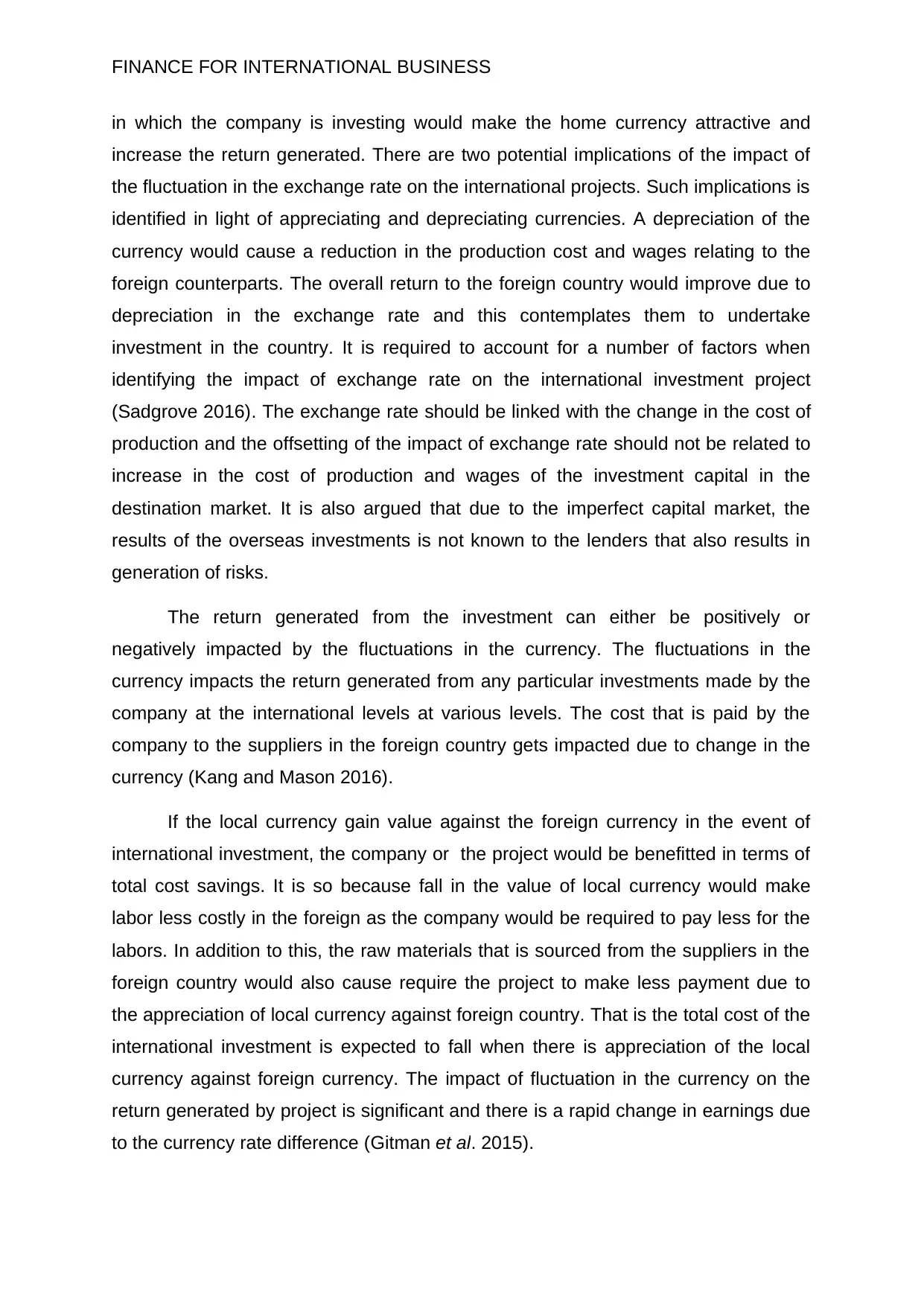
FINANCE FOR INTERNATIONAL BUSINESS
in which the company is investing would make the home currency attractive and
increase the return generated. There are two potential implications of the impact of
the fluctuation in the exchange rate on the international projects. Such implications is
identified in light of appreciating and depreciating currencies. A depreciation of the
currency would cause a reduction in the production cost and wages relating to the
foreign counterparts. The overall return to the foreign country would improve due to
depreciation in the exchange rate and this contemplates them to undertake
investment in the country. It is required to account for a number of factors when
identifying the impact of exchange rate on the international investment project
(Sadgrove 2016). The exchange rate should be linked with the change in the cost of
production and the offsetting of the impact of exchange rate should not be related to
increase in the cost of production and wages of the investment capital in the
destination market. It is also argued that due to the imperfect capital market, the
results of the overseas investments is not known to the lenders that also results in
generation of risks.
The return generated from the investment can either be positively or
negatively impacted by the fluctuations in the currency. The fluctuations in the
currency impacts the return generated from any particular investments made by the
company at the international levels at various levels. The cost that is paid by the
company to the suppliers in the foreign country gets impacted due to change in the
currency (Kang and Mason 2016).
If the local currency gain value against the foreign currency in the event of
international investment, the company or the project would be benefitted in terms of
total cost savings. It is so because fall in the value of local currency would make
labor less costly in the foreign as the company would be required to pay less for the
labors. In addition to this, the raw materials that is sourced from the suppliers in the
foreign country would also cause require the project to make less payment due to
the appreciation of local currency against foreign country. That is the total cost of the
international investment is expected to fall when there is appreciation of the local
currency against foreign currency. The impact of fluctuation in the currency on the
return generated by project is significant and there is a rapid change in earnings due
to the currency rate difference (Gitman et al. 2015).
in which the company is investing would make the home currency attractive and
increase the return generated. There are two potential implications of the impact of
the fluctuation in the exchange rate on the international projects. Such implications is
identified in light of appreciating and depreciating currencies. A depreciation of the
currency would cause a reduction in the production cost and wages relating to the
foreign counterparts. The overall return to the foreign country would improve due to
depreciation in the exchange rate and this contemplates them to undertake
investment in the country. It is required to account for a number of factors when
identifying the impact of exchange rate on the international investment project
(Sadgrove 2016). The exchange rate should be linked with the change in the cost of
production and the offsetting of the impact of exchange rate should not be related to
increase in the cost of production and wages of the investment capital in the
destination market. It is also argued that due to the imperfect capital market, the
results of the overseas investments is not known to the lenders that also results in
generation of risks.
The return generated from the investment can either be positively or
negatively impacted by the fluctuations in the currency. The fluctuations in the
currency impacts the return generated from any particular investments made by the
company at the international levels at various levels. The cost that is paid by the
company to the suppliers in the foreign country gets impacted due to change in the
currency (Kang and Mason 2016).
If the local currency gain value against the foreign currency in the event of
international investment, the company or the project would be benefitted in terms of
total cost savings. It is so because fall in the value of local currency would make
labor less costly in the foreign as the company would be required to pay less for the
labors. In addition to this, the raw materials that is sourced from the suppliers in the
foreign country would also cause require the project to make less payment due to
the appreciation of local currency against foreign country. That is the total cost of the
international investment is expected to fall when there is appreciation of the local
currency against foreign currency. The impact of fluctuation in the currency on the
return generated by project is significant and there is a rapid change in earnings due
to the currency rate difference (Gitman et al. 2015).
Paraphrase This Document
Need a fresh take? Get an instant paraphrase of this document with our AI Paraphraser
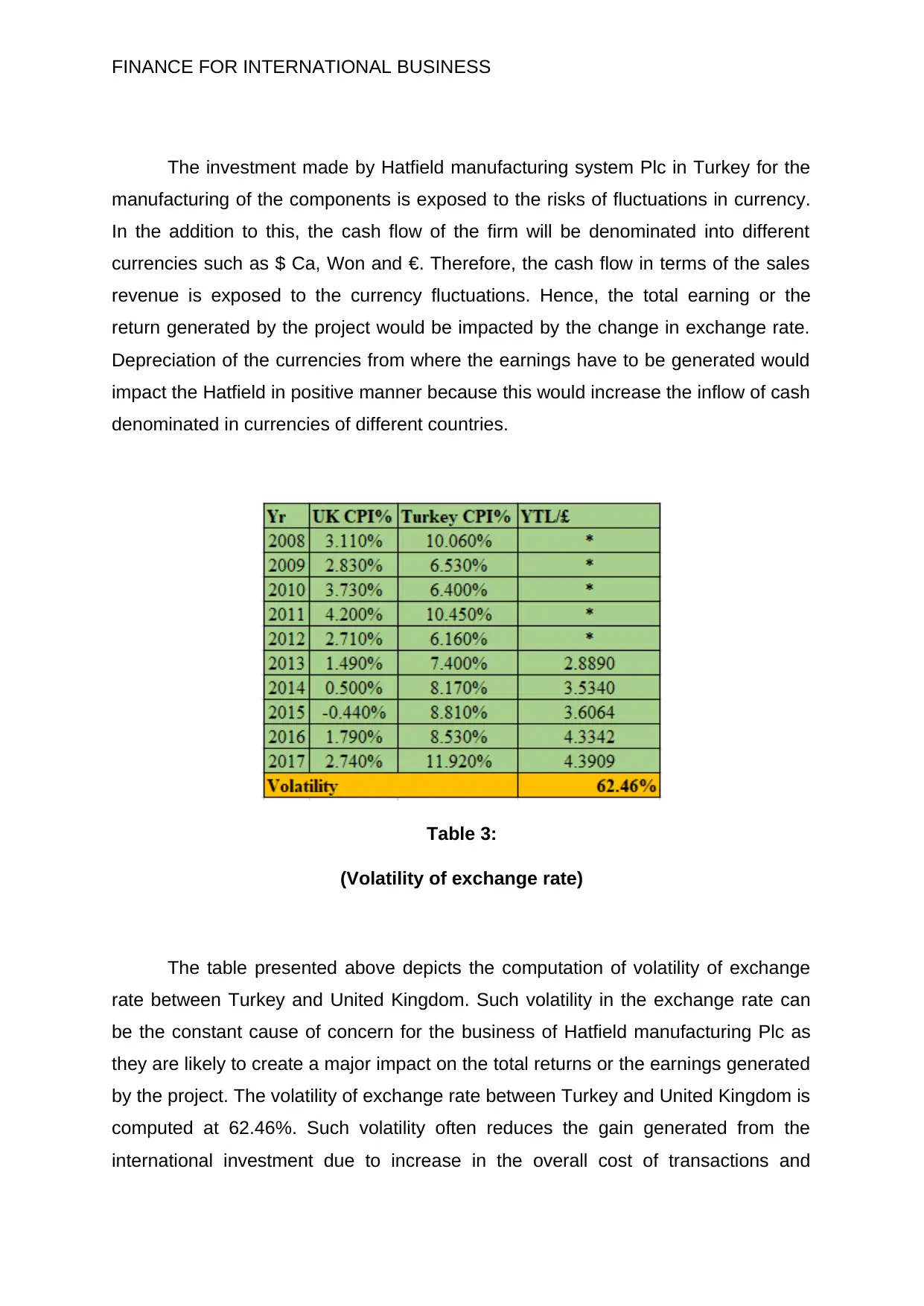
FINANCE FOR INTERNATIONAL BUSINESS
The investment made by Hatfield manufacturing system Plc in Turkey for the
manufacturing of the components is exposed to the risks of fluctuations in currency.
In the addition to this, the cash flow of the firm will be denominated into different
currencies such as $ Ca, Won and €. Therefore, the cash flow in terms of the sales
revenue is exposed to the currency fluctuations. Hence, the total earning or the
return generated by the project would be impacted by the change in exchange rate.
Depreciation of the currencies from where the earnings have to be generated would
impact the Hatfield in positive manner because this would increase the inflow of cash
denominated in currencies of different countries.
Table 3:
(Volatility of exchange rate)
The table presented above depicts the computation of volatility of exchange
rate between Turkey and United Kingdom. Such volatility in the exchange rate can
be the constant cause of concern for the business of Hatfield manufacturing Plc as
they are likely to create a major impact on the total returns or the earnings generated
by the project. The volatility of exchange rate between Turkey and United Kingdom is
computed at 62.46%. Such volatility often reduces the gain generated from the
international investment due to increase in the overall cost of transactions and
The investment made by Hatfield manufacturing system Plc in Turkey for the
manufacturing of the components is exposed to the risks of fluctuations in currency.
In the addition to this, the cash flow of the firm will be denominated into different
currencies such as $ Ca, Won and €. Therefore, the cash flow in terms of the sales
revenue is exposed to the currency fluctuations. Hence, the total earning or the
return generated by the project would be impacted by the change in exchange rate.
Depreciation of the currencies from where the earnings have to be generated would
impact the Hatfield in positive manner because this would increase the inflow of cash
denominated in currencies of different countries.
Table 3:
(Volatility of exchange rate)
The table presented above depicts the computation of volatility of exchange
rate between Turkey and United Kingdom. Such volatility in the exchange rate can
be the constant cause of concern for the business of Hatfield manufacturing Plc as
they are likely to create a major impact on the total returns or the earnings generated
by the project. The volatility of exchange rate between Turkey and United Kingdom is
computed at 62.46%. Such volatility often reduces the gain generated from the
international investment due to increase in the overall cost of transactions and
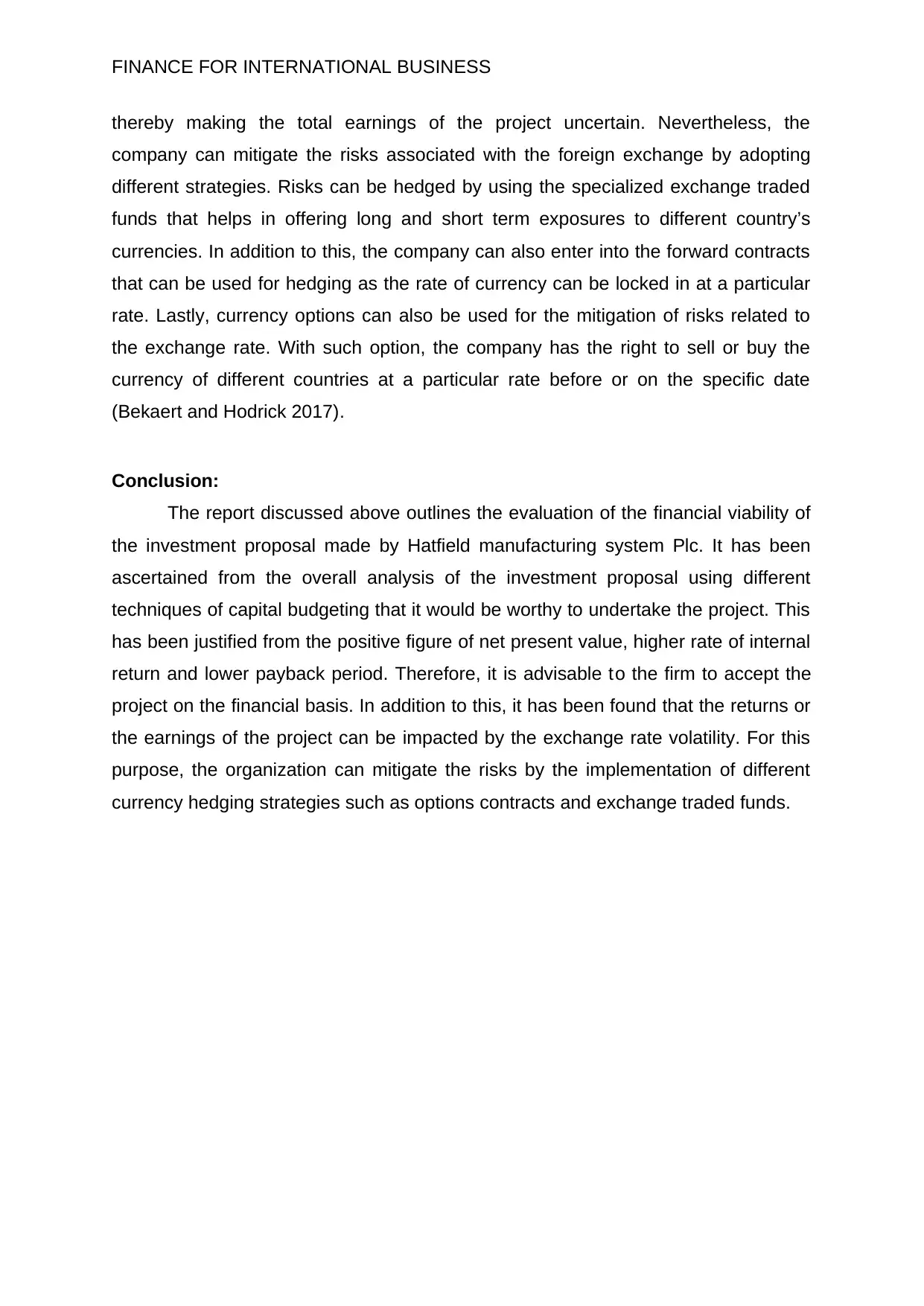
FINANCE FOR INTERNATIONAL BUSINESS
thereby making the total earnings of the project uncertain. Nevertheless, the
company can mitigate the risks associated with the foreign exchange by adopting
different strategies. Risks can be hedged by using the specialized exchange traded
funds that helps in offering long and short term exposures to different country’s
currencies. In addition to this, the company can also enter into the forward contracts
that can be used for hedging as the rate of currency can be locked in at a particular
rate. Lastly, currency options can also be used for the mitigation of risks related to
the exchange rate. With such option, the company has the right to sell or buy the
currency of different countries at a particular rate before or on the specific date
(Bekaert and Hodrick 2017).
Conclusion:
The report discussed above outlines the evaluation of the financial viability of
the investment proposal made by Hatfield manufacturing system Plc. It has been
ascertained from the overall analysis of the investment proposal using different
techniques of capital budgeting that it would be worthy to undertake the project. This
has been justified from the positive figure of net present value, higher rate of internal
return and lower payback period. Therefore, it is advisable to the firm to accept the
project on the financial basis. In addition to this, it has been found that the returns or
the earnings of the project can be impacted by the exchange rate volatility. For this
purpose, the organization can mitigate the risks by the implementation of different
currency hedging strategies such as options contracts and exchange traded funds.
thereby making the total earnings of the project uncertain. Nevertheless, the
company can mitigate the risks associated with the foreign exchange by adopting
different strategies. Risks can be hedged by using the specialized exchange traded
funds that helps in offering long and short term exposures to different country’s
currencies. In addition to this, the company can also enter into the forward contracts
that can be used for hedging as the rate of currency can be locked in at a particular
rate. Lastly, currency options can also be used for the mitigation of risks related to
the exchange rate. With such option, the company has the right to sell or buy the
currency of different countries at a particular rate before or on the specific date
(Bekaert and Hodrick 2017).
Conclusion:
The report discussed above outlines the evaluation of the financial viability of
the investment proposal made by Hatfield manufacturing system Plc. It has been
ascertained from the overall analysis of the investment proposal using different
techniques of capital budgeting that it would be worthy to undertake the project. This
has been justified from the positive figure of net present value, higher rate of internal
return and lower payback period. Therefore, it is advisable to the firm to accept the
project on the financial basis. In addition to this, it has been found that the returns or
the earnings of the project can be impacted by the exchange rate volatility. For this
purpose, the organization can mitigate the risks by the implementation of different
currency hedging strategies such as options contracts and exchange traded funds.
⊘ This is a preview!⊘
Do you want full access?
Subscribe today to unlock all pages.

Trusted by 1+ million students worldwide

FINANCE FOR INTERNATIONAL BUSINESS
Paraphrase This Document
Need a fresh take? Get an instant paraphrase of this document with our AI Paraphraser
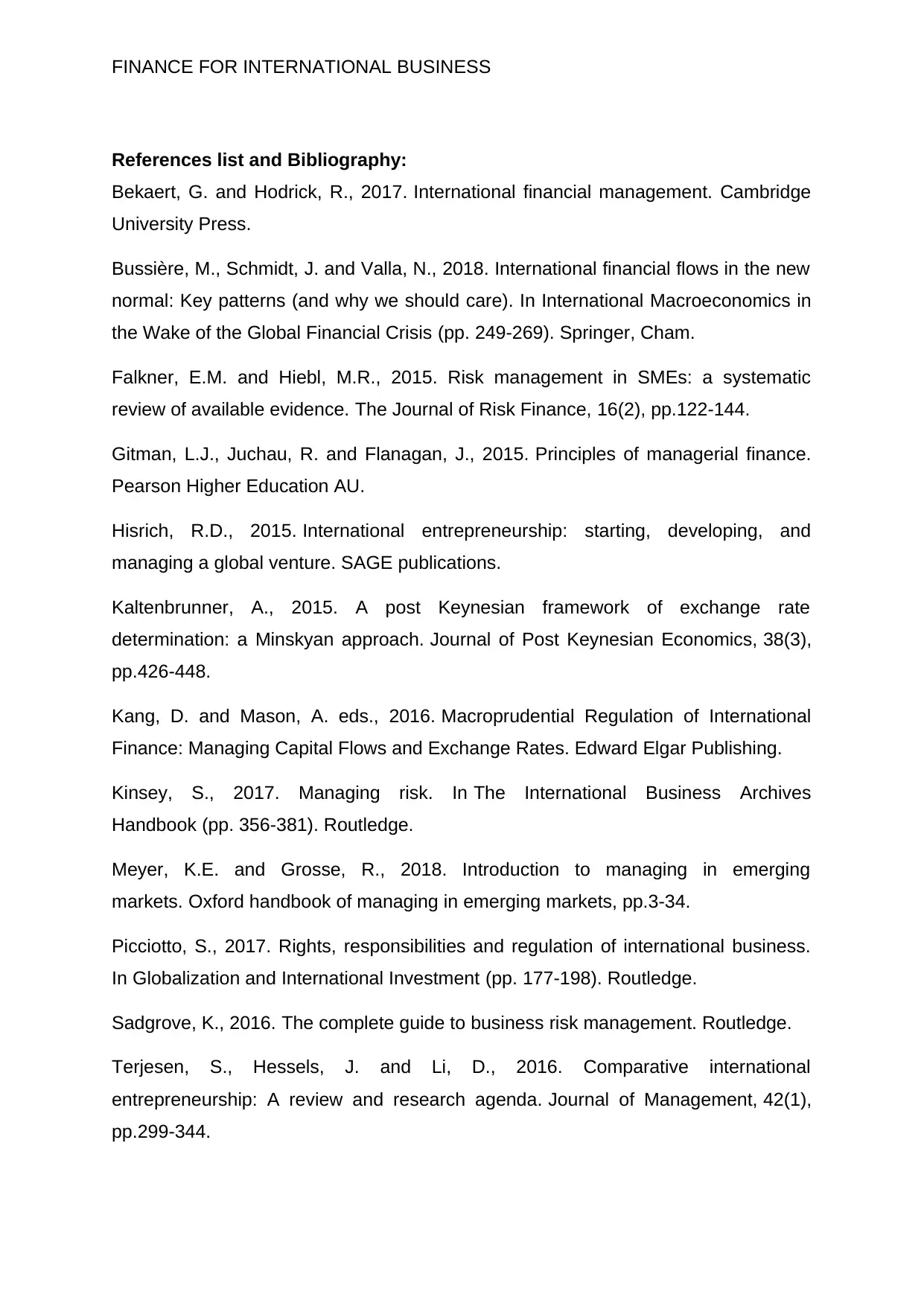
FINANCE FOR INTERNATIONAL BUSINESS
References list and Bibliography:
Bekaert, G. and Hodrick, R., 2017. International financial management. Cambridge
University Press.
Bussière, M., Schmidt, J. and Valla, N., 2018. International financial flows in the new
normal: Key patterns (and why we should care). In International Macroeconomics in
the Wake of the Global Financial Crisis (pp. 249-269). Springer, Cham.
Falkner, E.M. and Hiebl, M.R., 2015. Risk management in SMEs: a systematic
review of available evidence. The Journal of Risk Finance, 16(2), pp.122-144.
Gitman, L.J., Juchau, R. and Flanagan, J., 2015. Principles of managerial finance.
Pearson Higher Education AU.
Hisrich, R.D., 2015. International entrepreneurship: starting, developing, and
managing a global venture. SAGE publications.
Kaltenbrunner, A., 2015. A post Keynesian framework of exchange rate
determination: a Minskyan approach. Journal of Post Keynesian Economics, 38(3),
pp.426-448.
Kang, D. and Mason, A. eds., 2016. Macroprudential Regulation of International
Finance: Managing Capital Flows and Exchange Rates. Edward Elgar Publishing.
Kinsey, S., 2017. Managing risk. In The International Business Archives
Handbook (pp. 356-381). Routledge.
Meyer, K.E. and Grosse, R., 2018. Introduction to managing in emerging
markets. Oxford handbook of managing in emerging markets, pp.3-34.
Picciotto, S., 2017. Rights, responsibilities and regulation of international business.
In Globalization and International Investment (pp. 177-198). Routledge.
Sadgrove, K., 2016. The complete guide to business risk management. Routledge.
Terjesen, S., Hessels, J. and Li, D., 2016. Comparative international
entrepreneurship: A review and research agenda. Journal of Management, 42(1),
pp.299-344.
References list and Bibliography:
Bekaert, G. and Hodrick, R., 2017. International financial management. Cambridge
University Press.
Bussière, M., Schmidt, J. and Valla, N., 2018. International financial flows in the new
normal: Key patterns (and why we should care). In International Macroeconomics in
the Wake of the Global Financial Crisis (pp. 249-269). Springer, Cham.
Falkner, E.M. and Hiebl, M.R., 2015. Risk management in SMEs: a systematic
review of available evidence. The Journal of Risk Finance, 16(2), pp.122-144.
Gitman, L.J., Juchau, R. and Flanagan, J., 2015. Principles of managerial finance.
Pearson Higher Education AU.
Hisrich, R.D., 2015. International entrepreneurship: starting, developing, and
managing a global venture. SAGE publications.
Kaltenbrunner, A., 2015. A post Keynesian framework of exchange rate
determination: a Minskyan approach. Journal of Post Keynesian Economics, 38(3),
pp.426-448.
Kang, D. and Mason, A. eds., 2016. Macroprudential Regulation of International
Finance: Managing Capital Flows and Exchange Rates. Edward Elgar Publishing.
Kinsey, S., 2017. Managing risk. In The International Business Archives
Handbook (pp. 356-381). Routledge.
Meyer, K.E. and Grosse, R., 2018. Introduction to managing in emerging
markets. Oxford handbook of managing in emerging markets, pp.3-34.
Picciotto, S., 2017. Rights, responsibilities and regulation of international business.
In Globalization and International Investment (pp. 177-198). Routledge.
Sadgrove, K., 2016. The complete guide to business risk management. Routledge.
Terjesen, S., Hessels, J. and Li, D., 2016. Comparative international
entrepreneurship: A review and research agenda. Journal of Management, 42(1),
pp.299-344.
1 out of 11
Related Documents
Your All-in-One AI-Powered Toolkit for Academic Success.
+13062052269
info@desklib.com
Available 24*7 on WhatsApp / Email
![[object Object]](/_next/static/media/star-bottom.7253800d.svg)
Unlock your academic potential
Copyright © 2020–2025 A2Z Services. All Rights Reserved. Developed and managed by ZUCOL.





